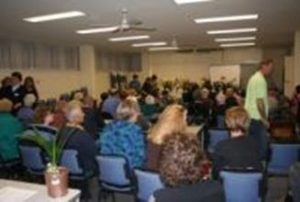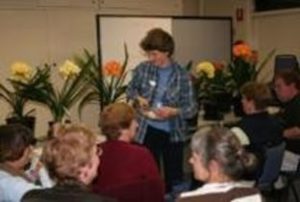The beginnings of a Clivia Club
by Helen Marriott
Following an invitation from Michael Barrett to speak on this topic at the February (2018) meeting of the Melbourne Clivia Group (MCG), I presented a short outline of my own experiences and recollections leading up to the formation of the MCG, and briefly referred to the launch of the club and its beginnings. I also thought it of value to provide some contextual background to the topic in relation to other international and national club developments.
International context
The Clivia Club commenced in South Africa in 1992, starting first as a newsletter and then was formally established with a committee in September 1994. Over time, different activities took place and subsequent groups were formed in different locations, leading to a revised and expanded constitution, and the renaming of the Clivia Club to the Clivia Society in May 2001. The Clivia Society acts as an umbrella body to constituent clubs, of which there are now 10 in South Africa as well as four interest groups, and to overseas members. Australia has always had a substantial number of individuals who are members of this Clivia Society. Ken Smith acted as the Australian representative of the Clivia Society for a number of years and Lisa Fox has been fulfilling this role since 2016.

The various separate clubs in South Africa run impressive competitive shows and the Society is continuing to work on the standards and judging of Clivia to become more consistent across the various clubs. Every four years the Clivia Society runs a quadrennial conference in association with the show of the host club. This year the conference will be hosted by the Joburg (Johannesburg) Club in early September. This event is often accompanied by a habitat tour or tours.
The New Zealand Clivia Club was formed in March 2003, with Keith Hammett elected as the Chairperson, and incorporation followed in May of that year. This club was preceded by a group of growers staging a show the previous year and it has been stated that the club was born “from the interest generated from this exhibition” (http://www.nzclivia.org/AboutUsPage.htm ). Shows are now held regularly in Auckland, Tauranga and Palmerston North. Newsletters were issued by the club between 2003 and 2014 and are available on line.
The North American Clivia Society (NACS) issued its augural newsletter in the autumn of 2003, where it outlined its leadership team, consisting of a President (Jim Shields), Vice-President and Board of Directors. They simultaneously announced the establishment of a website (http://www.northamericancliviasociety.org). This site, along with the newsletter, have been maintained since. In mid-March 2018 the organisation held its 15th annual show and sale at The Huntington Library, Art Collections, and Botanical Gardens in San Marino, California. Originally commencing as a display, the club moved to a competitive show some years ago. Another show is generally held at the Longwood Gardens in Pennsylvania a week prior to the show in California.
National context
There are three Clivia clubs in Australia. In order of their establishment these are the Toowoomba Clivia Society, the Melbourne Clivia Group and the Clivia Society of New South Wales.
The Toowoomba Clivia Society was established over 12 years ago and often promotes Toowoomba as being the ‘Clivia Capital of Australia’. A document on its website (https://toowoombacliviasociety.com.au ) outlines how its formal beginning in August 2005 was preceded by some earlier displays of Clivia:

The Toowoomba Clivia Society had its beginnings as an incorporated body in August 2005, but for a couple of years before that operated as a nonincorporated club when several members pooled their resources and held the first Clivia exhibition at Walsh’s Garden Centre, Toowoomba.
The annual Clivia shows at Toowoomba are always part of the bigger Carnival of Flowers in that city. The club has produced short newsletters and in recent years has added a club website.
The Clivia Society of NSW was the third Australian club to get off the ground, with their first newsletter published in summer 2014 when they announced their establishment and founding members, with Chris Ong as inaugural President. They have run an annual show since 2014 and updated the format of their newsletter several years ago. The club has plans to hold its first RARE CLIVIA EXPO in June 2018, which will focus mainly on interspecifics. So far, their online presence is maintained through a Facebook page.
Melbourne context
At the local level, there were attempts to organise a small group of Clivia-interested people in Melbourne, but it took until 2008 for a continuing group to be established. In 2001 a small exhibition was organised by Judy Shevlin and her husband. Laurens Rijke was the main exhibitor of splendid Clivia. In the ensuing years this was followed by a couple of meetings convened by Bryan Patten and subsequently by David Bearlin.
By around 2008 I was personally feeling frustrated and had the feeling that we Melburnians weren’t working hard enough to get a Clivia club off the ground in comparison with what has happening in South Africa in particular, but also in Toowoomba, New Zealand and the USA. I had been growing Clivia for 10 years at that time and had started my own crosses with ‘Aurea’ and other material. I joined the Clivia Society around 2000 and collected and read all of their back literature, participated in the Yahoo internet group, and had been to the Toowoomba show five or so times. I had attended the quadrennial conference of the Clivia Society in 2006 where I delivered a presentation on Nakamura’s breeding, as I had started to visit him regularly in Japan from 2003.
I had attended all the small events in Melbourne which all promised follow-on but which did not. Obviously, there were also others in Melbourne who had developed a strong interest in Clivia by this time and shared a similar keenness to get a club going. I am sure that many of those people who were present at that time in 2008 and who remain keen members of the MCG will have their own personal stories about their developing commitment to Clivia up until 2008 and/or since that time.
Fortunately, there was a sufficient number of people present at the meeting on 15 August 2008 who wanted to start afresh by forming a new, independent group and they elected a committee to run a new club. This was done by nomination on the spot or by others volunteering their services. This first committee consisted of myself (President), Lisa Fox (Secretary), Rae Begg (Treasurer) and Di Mathews (member, then Vice-President) and subsequently expanded to include Brenda Girdlestone and George Simmler.
On that night in August, we brainstormed a name together, coming up with the Melbourne Clivia Group (MCG). Friday nights were chosen as the night to suit most working people for the meetings. The committee started meeting soon after to commence planning, which included a decision to commission a logo from John Bannenberg and to affiliate with the Royal Horticultural Society of Victoria (RHSV) for insurance purposes. The step to incorporate the Group was also commenced and lodged in November of that year.
I convened the first full meeting of the MCG as president on 12 September 2008 and another meeting was held on 17 October. From 2009 onwards approximately bi-monthly meetings were held, a regular newsletter was produced (hardcopy and electronic formats) and a website was developed. A major new development in September 2010 was the launch of the first MCG CLIVIA EXPO, the name being chosen because, still being a small group, we designed a number of activities for the day in case there were insufficient plants for the event to be called a “show”. This event has been continued annually and in 2016 an auction of Clivia plants was held as part of the CLIVIA EXPO and definitely added to the excitement of the day.
From the outset, by designing an annual calendar of events and activities an effort was made by the MCG Committee to cater to both novices and experienced growers. A program to utilise or specifically invite interstate speakers once a year was also commenced. Among other initiatives along the way was the systematisation of the club’s electronic filing system as well as the introduction of an online sharing of documents by committee members, online banking was established and PayPal was added for members’ convenience. A Facebook page was also established a few years ago to facilitate members’ communication.
In conclusion, I have attempted to briefly explain that it took a number of years and attempts to finally get a Clivia club up and running in Melbourne. I think that effective leadership through the committee is essential for the operation of a successful club but so too is the active participation of members and their willingness to behave as good citizens within that community. At times it was harder than it should have been to develop and implement fair and appropriate policies and practices for the MCG, especially in those earlier years. Since 2018 marks the tenth anniversary of the MCG, I hope there will be reason to celebrate our various achievements as well as reflect on how we can do better. I also hope that there will be sufficient committed and capable persons who will continue to do the work needed for the club to thrive in the future.

